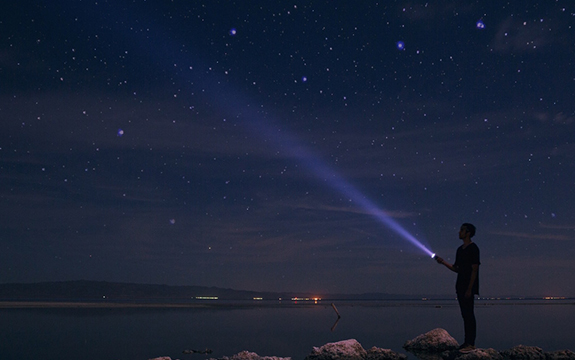How we plan to bring dark matter to light

In Summary
Alan Duffy, Swinburne University of Technology and Elisabetta Barberio, University of Melbourne
Long before we had the atomic theory of matter, scientists knew the air was real, even though it was invisible. This was because we could see its action as the wind caressed the leaves in trees.
Likewise we see the influence of another invisible force in the wider cosmos in the movement of stars within galaxies. But we don’t yet know what this mysterious “dark matter” is made of.
Now a new generation of detectors – including one we’re building in a gold mine in Victoria – is giving us hope that we might finally shed some light on dark matter.
Glow in the dark
Some models predict that whatever particle makes up dark matter is also its own antiparticle. This leads to the fascinating prediction that if two dark matter particles interact they annihilate into a shower of either exotic particles or radiation.
If it annihilates into particles, then space-based detectors, such as the Alpha Magnetic Spectrometer (AMS) on the International Space Station, might detect unusual numbers of, say, positrons. If it annihiliates into radiation (or if the positrons themselves annihilate), then the radiation will be in the form of highly energetic gamma-rays, which could be detected by NASA’s Fermi Gamma-ray Space Telescope orbiting above the Earth.
 The Alpha Magnetic Spectrometer mounted on the International Space Station could help detect the signs of dark matter. NASA
The Alpha Magnetic Spectrometer mounted on the International Space Station could help detect the signs of dark matter. NASA
If so, the signal will be strongest where the density of dark matter is highest. This could be near the centre of our galaxy, where it is pulled close by the enormous gravity of the densely-packed stars and supermassive black hole.
Unfortunately, black holes and nearby exploding stars can all produce similar signals to annihilating dark matter. This makes it hard to discriminate any dark matter signal from black hole or supernovae noise.
However, if we were to find a clump of dark matter that was glowing brightly in gamma-rays, and there were barely any stars within, then we could be far more confident that we were seeing signs of dark matter.
Fortunately, there are such objects orbiting the Milky Way, known as an ultra-faint dwarf spheroidal galaxies. But, unfortunately, there appears to be no confirmed detection of gamma-rays from these objects, although there are hints there might be something interesting going on within.
To confirm the nature of dark matter there is no substitute for direct detection in the lab. It might be possible to produce dark matter during collisions in the Large Hadron Collider at CERN, in which case it would fly through the detectors without ever setting them off.
Its presence would be revealed in the same way as a dodgy accountant: we measure all the energy that goes into a collision, and we measure all the energy that comes out. If it doesn’t add up, we know that some energy has escaped in the form of dark matter.
 The Large Hadron Collider might be able to create dark matter particles. CERN
The Large Hadron Collider might be able to create dark matter particles. CERN
Digging for dark gold
There is another option, and that is to try to detect the naturally occurring dark matter of our galaxy that the Earth ploughs through each year. This relies on the ghost-like dark matter colliding with the nucleus of an atom in a head-on collision.
Indeed, in the time it’s taken you to read this article, it’s likely that you’ve had an atom knocked away by a dark matter particle. It’s unlikely that you felt it, though, as humans make for bad detectors. But we’re building a better one.
With an international consortium of universities, research agencies and industry we are constructing the Stawell Underground Physics Laboratory (SUPL) a kilometre underground at a gold mine in Stawell, Victoria. This will house the world’s first dark matter detector in the southern hemisphere, known as SABRE.
We use the layers of rock above to block radiation from space that would otherwise overwhelm our sensitive detector. This ensures that only the ghostly dark matter is able to pass through the solid rock, and will occasionally collide with the detector.
 Some of the lead scientists of the SABRE experiment in the Stallwell gold mine. In the background is the radiation testing facility. Carl Knox (Swinburne University), Author provided
Some of the lead scientists of the SABRE experiment in the Stallwell gold mine. In the background is the radiation testing facility. Carl Knox (Swinburne University), Author provided
The SABRE experiment consists of an ultra-pure sodium iodide crystal doped with thallium that has extraordinarily low levels of radiation (we don’t want to see our own radioactive “glow” after all). This unique crystal, created by Princeton’s Professor Frank Calaprice, will occasionally be struck by a dark matter particle, causing the nucleus of an atom to recoil away like a game of billiards. The atom will be energetically excited during the collision and eventually release this energy as a high energy gamma-ray.
The sodium iodide crystal itself is a natural scintillator, taking this gamma-ray and producing a flash of optical light that the sensitive cameras around the crystal can detect. So, in hunting for ghosts, we look for faint flashes of light in the dark.
We hope that, in time, we might finally shed some light on dark matter, and gain an insight into this mysterious substance that makes up five times more of the mass of the universe than what we can see.![]()
Alan Duffy, Research Fellow, Swinburne University of Technology and Elisabetta Barberio, Professor of High Energy Physics, University of Melbourne
This article was originally published on The Conversation. Read the original article.

